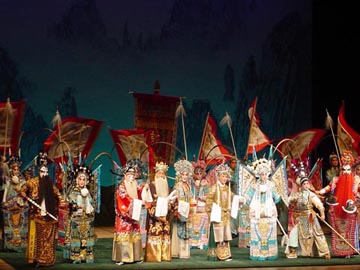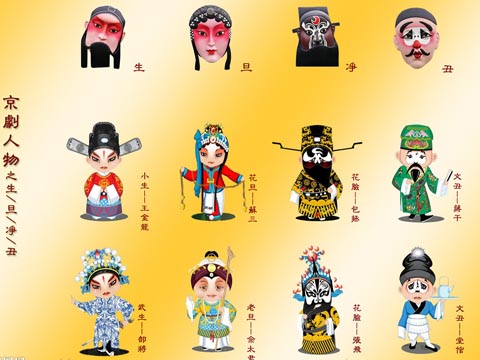|
The Peking Opera, the quintessence
of Chinese culture, began to be formed on the basis of the Hui Opera from
Anhui and Han Opera from Hubei. 300 years ago in the reign of Emperor
Kangxi, Geyang and Kun melodies were prevailed in the area of Beijing.
During Emperor Qianlong’s reign, Qin Opera came to Beijing. In 1781, a
Hui Opera Troup headed by a famous actor came to Beijing to perform for
the Emperor. Later the Hui Opera developed in Beijing and absorbed essence
from other operas. In the middle of 19th century, Han Opera came to Beijing,
The Hui Opera and Han Opera often performed together, they learned from
each other. Later Peking Opera came into being on the basic melody of
Erhuang of Hui Opera and Xipi melody of Han Opera and combining Beijing
local accent.
Features of playing
The art of Peking Opera is a kind of composite one consisting of literature, music, dance, fine arts, martial arts and acrobatics. Its performance art and artistic forms have four distinctive features, namely every action in a play is stylized, symbolic, rhythmical and exaggerated. To be stylized means put singing, narration, action and wrestling into a given form according to different roles. To be symbolic means to use props to symbol real things or to use gestures to symbol actions in reality. To be rhythmical means every action done in rhythm. To be exaggerated means the actions and expressions performed are exaggerated.
The Peking Opera has special tunes. To keep the peace with the changing emotions of actors and plots the tunes must be changed accordingly. So from the music tunes the audience can have a better understanding of the opera. The tunes crate the atmosphere necessary for the unfolding of the plot.
Types of roles in Peking Opera
The roles in Peking Opera are classified into the following types: Sheng (male roles), Dan (female role), Jing (painted- face) and Chou (clown).
Sheng is divided into Laosheng and Xiaosheng. Laosheng, namely, handsome middle aged and old aged male roles who wear beards and whose faces are not painted. A laosheng must be good at acting, singing and often plays the role of court official, scholar or man of gentility. Xiaosheng, namely, is a handsome young gentleman, scholar or warrior’s role. Dan can be divided into Qinyi, Huadan and Wudan. Qinyi is a role of beautiful young or middle-aged role. She is good at dancing, singing and recitation. Huadan is the role of lovely young lady with beautiful movement. Wudan plays the role of swordswoman or fairy with good martial skills. Laodan is the role of elder lady good at sings with natural voice. Jing is a role with painted face to show vivid expression and characteristics. He always plays the role of ministers, officers, the emperor, prince and he is good at singing, martial arts or narrations. Chou, clown, is easily recognized by the nose which is painted powder-white. Chou is good at singing, spoken art and martial skills.
Facial makeup
The facial makeup of Peking Opera is in accord with its performing style. Different techniques are used to apply paint to actor’s face and eyebrows, thus indicating the age, sex and personality of the character. The headdress, costume and boots indicate a character’s status. The painted face should be in bright colors with different lines to express the personality and its inner world. The colors usually used include red, pink, black, purple, gray, blue, green, yellow, white, etc. Generally, red indicates the character is loyal, courageous and upright. Black indicates a firm and frank nature. White indicates treacherous. Purple symbolizes being steady and cautious. Yellow indicates being efficient or fierce. Blue means boldness. Green means stubborn and cruel. Pink means kind. Characters of ghosts, monsters and immortals often have their faces painted with gold and silver colors.
The costume
The costumes are divided into five groups: Mang (ceremonial robe), Kao (armor), Zhe (lined coat), Pei (robe), Yi (coat). The colors of the costumes are divided into the upper five colors: (red, green, yellow, white and black) and the lower five colors: (purple, pink, blue, light green and deep red). The costumes are in different colors and designs according to the different social status of the characters. For instance, the royal family members wear ceremonial robes or lined coats embroidered with dragon and phoenix. The court officials and ministers wear ceremonial robes and official robes embroidered with crane and peacock. The generals wear ceremonial robe and armor robe embroidered with unicorn, tiger and leopard. The gentries wear lined coats and robes embroidered with birds and flowers. The ordinary people lined coats, robe and coat without embroideries.
Helmets and headgears
The helmets and headgears worn in Peking Opera are in keeping the status and age of the characters and their costumes.
The helmets worn by male characters include the tiger head helmet, the lion helmet, the lotus leaf helmet and tassel helmet, etc. The female characters were seven-star helmet and butterfly helmet, etc. Crowns include flat crown, nine-dragon crown, phoenix crown, jade crown and marten crown, etc. There are kerchiefs for various characters such as official, scholar, student and military officer. Hats are divided into soft hat and military hat.
Elaborately made headgear of various styles such as Datou, ancient style and Manchu style would be worn by female.
Pheasant plumes and foxtails are worn with the costume to indicate the characters’ age and personality.
Peking Opera Ensemble
It consists of eight to ten people playing Chinese wind, stringed and percussion instruments. Such techniques as blowing, hitting, pulling and flicking, are used in playing. It has two sub-groups, one is for playing with non-fighting scenes and the other is for the fighting scene. For playing non-fighting scenes, the instruments used include Jinghu (Beijing fiddle),jingerhu (the second Beijing fiddle), Sanxian (three-stringed guitar) Yueqin (moon mandolin), bamboo flute, Suona (Chinese clarinet), Haidi (flute), and Sheng (reed organ), etc. For playing with the fighting scenes, the percussion instruments are used, which include drums, gongs, cymbal, etc.
The ensemble both provides vocal accompaniment and plays melodies on its own so as to harmonize singing, recitation, actions, martial skills and dancing. That gives effect to express emotions, cooperated actions taking place on the stage, and leads to the unfolding plot.
Features of playing
The art of Peking Opera is a kind of composite one consisting of literature, music, dance, fine arts, martial arts and acrobatics. Its performance art and artistic forms have four distinctive features, namely every action in a play is stylized, symbolic, rhythmical and exaggerated. To be stylized means put singing, narration, action and wrestling into a given form according to different roles. To be symbolic means to use props to symbol real things or to use gestures to symbol actions in reality. To be rhythmical means every action done in rhythm. To be exaggerated means the actions and expressions performed are exaggerated.
The Peking Opera has special tunes. To keep the peace with the changing emotions of actors and plots the tunes must be changed accordingly. So from the music tunes the audience can have a better understanding of the opera. The tunes crate the atmosphere necessary for the unfolding of the plot.
Types of roles in Peking Opera
The roles in Peking Opera are classified into the following types: Sheng (male roles), Dan (female role), Jing (painted- face) and Chou (clown).
Sheng is divided into Laosheng and Xiaosheng. Laosheng, namely, handsome middle aged and old aged male roles who wear beards and whose faces are not painted. A laosheng must be good at acting, singing and often plays the role of court official, scholar or man of gentility. Xiaosheng, namely, is a handsome young gentleman, scholar or warrior’s role. Dan can be divided into Qinyi, Huadan and Wudan. Qinyi is a role of beautiful young or middle-aged role. She is good at dancing, singing and recitation. Huadan is the role of lovely young lady with beautiful movement. Wudan plays the role of swordswoman or fairy with good martial skills. Laodan is the role of elder lady good at sings with natural voice. Jing is a role with painted face to show vivid expression and characteristics. He always plays the role of ministers, officers, the emperor, prince and he is good at singing, martial arts or narrations. Chou, clown, is easily recognized by the nose which is painted powder-white. Chou is good at singing, spoken art and martial skills.
Facial makeup
The facial makeup of Peking Opera is in accord with its performing style. Different techniques are used to apply paint to actor’s face and eyebrows, thus indicating the age, sex and personality of the character. The headdress, costume and boots indicate a character’s status. The painted face should be in bright colors with different lines to express the personality and its inner world. The colors usually used include red, pink, black, purple, gray, blue, green, yellow, white, etc. Generally, red indicates the character is loyal, courageous and upright. Black indicates a firm and frank nature. White indicates treacherous. Purple symbolizes being steady and cautious. Yellow indicates being efficient or fierce. Blue means boldness. Green means stubborn and cruel. Pink means kind. Characters of ghosts, monsters and immortals often have their faces painted with gold and silver colors.
The costume
The costumes are divided into five groups: Mang (ceremonial robe), Kao (armor), Zhe (lined coat), Pei (robe), Yi (coat). The colors of the costumes are divided into the upper five colors: (red, green, yellow, white and black) and the lower five colors: (purple, pink, blue, light green and deep red). The costumes are in different colors and designs according to the different social status of the characters. For instance, the royal family members wear ceremonial robes or lined coats embroidered with dragon and phoenix. The court officials and ministers wear ceremonial robes and official robes embroidered with crane and peacock. The generals wear ceremonial robe and armor robe embroidered with unicorn, tiger and leopard. The gentries wear lined coats and robes embroidered with birds and flowers. The ordinary people lined coats, robe and coat without embroideries.
Helmets and headgears
The helmets and headgears worn in Peking Opera are in keeping the status and age of the characters and their costumes.
The helmets worn by male characters include the tiger head helmet, the lion helmet, the lotus leaf helmet and tassel helmet, etc. The female characters were seven-star helmet and butterfly helmet, etc. Crowns include flat crown, nine-dragon crown, phoenix crown, jade crown and marten crown, etc. There are kerchiefs for various characters such as official, scholar, student and military officer. Hats are divided into soft hat and military hat.
Elaborately made headgear of various styles such as Datou, ancient style and Manchu style would be worn by female.
Pheasant plumes and foxtails are worn with the costume to indicate the characters’ age and personality.
 |
 |
Peking
Opera Performance |
Peking
Opera Ficial
Art |
Peking Opera Ensemble
It consists of eight to ten people playing Chinese wind, stringed and percussion instruments. Such techniques as blowing, hitting, pulling and flicking, are used in playing. It has two sub-groups, one is for playing with non-fighting scenes and the other is for the fighting scene. For playing non-fighting scenes, the instruments used include Jinghu (Beijing fiddle),jingerhu (the second Beijing fiddle), Sanxian (three-stringed guitar) Yueqin (moon mandolin), bamboo flute, Suona (Chinese clarinet), Haidi (flute), and Sheng (reed organ), etc. For playing with the fighting scenes, the percussion instruments are used, which include drums, gongs, cymbal, etc.
The ensemble both provides vocal accompaniment and plays melodies on its own so as to harmonize singing, recitation, actions, martial skills and dancing. That gives effect to express emotions, cooperated actions taking place on the stage, and leads to the unfolding plot.
We can help you to get discount tickets in Beijing to enjoy Peking Opera.
Mobile:(+86-1350 110 3837) Fax:(0086-10-6585 4230) E-mail: chinasilkrug@msn.com